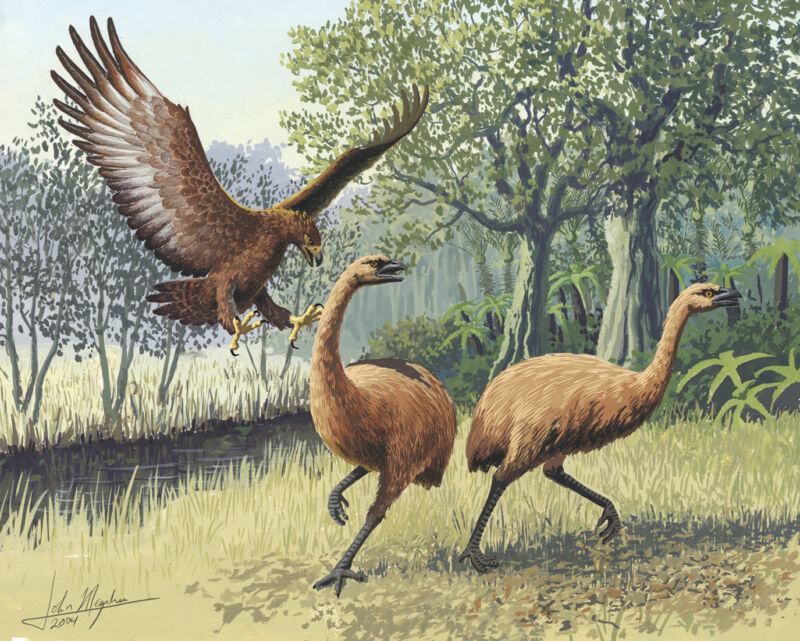
New Zealand has long been known as a place for the birds—quite literally. Before people arrived 700 years ago, the archipelago hosted an idiosyncratic ecosystem, nearly free of mammals. More than 200 bird species filled a food web all their own. Rather than cows or antelopes, there was a family of flightless birds known as moa. And in place of apex predators like tigers, New Zealand had Haast’s eagle.
Ever since a group of farm workers drained a swamp in the late 1860s and uncovered its buried bones, this eagle has captivated researchers. Julius Haast, the explorer and geologist who published the first notes on the species, described it as “a raptorial bird of enormous dimensions.” Today, biologists estimate that the eagles weighed up to 33 pounds—roughly 50 percent more than any raptor known today. But with a wingspan of only two to three meters—just beyond the range of a bald eagle—this was an oddly proportioned bird.
The shape of Haast’s eagle was one of many puzzles that scientists faced as they studied this long-extinct species, preserved in just a few skeletons, plus scattered bits and pieces. For nearly a century, there was a debate over whether such a large bird could fly; even after that feud was settled, questions remained about whether the bird was capable of killing moa, which in some cases would have been more than 15 times larger than the eagle itself. Now, new scientific techniques, combined with a clearer understanding of New Zealand’s geological history, has placed the Haast’s eagle amid a much larger ecological discussion: how species comes to “invade” new territories.
Scientists now believe that this superlative bird was one in a wave of feathered invaders that conquered New Zealand over a relatively short period. And this was not the only wave of invasions. Haast’s eagle—despite being gone for centuries—has revealed that we live in a much more connected world than we once thought, says biologist Michael Knapp of the University of Otago, who has studied the eagle. If such seemingly isolated islands have repeatedly attracted so many incoming species, he says, then “natural invasions” must be a major force in ecosystems across the world.
Digging for answers
New Zealand has always held an important place in scientists’ understanding of extinction. When Western scientists first encountered moa, the idea that species could go extinct was just a few decades old. Their skeletons soon became a hot commodity. “You could pretty much name your price,” says paleobiologist Paul Scofield, senior curator at the Canterbury Museum in Christchurch. “It was really what enabled our museum.” Haast himself launched the museum and assembled its initial collection by exchanging moa fossils for various other archeological and zoological curiosities.
New Zealand retained unusual species—including, famously, the flightless kiwi. Combined with these extant oddballs, the moa fossils helped to establish the idea that New Zealand was a lost world, a place where ancient creatures, sheltered by distance from the rest of the world, managed to survive mass extinction events. Later geologists confirmed that these rocky islands had once been a part of a supercontinent they called Gondwana, but split away about 80 million years ago. In 1990, a television series described New Zealand’s islands as “Moa’s Ark,” popularizing the catchy name of the long-held model of how its bird-filled ecosystem came to be.
By the end of the 1990s, though, scientists realized that there was a period during the Oligocene, about 25 million years ago, when geologic and climatic changes might have put all of New Zealand underwater. Such a flood would have wiped out most—if not all—of the islands’ species. The theory, which became known as the “Oligocene drowning,” met resistance from some scientists, launching a heated debate over just how much land was covered.
Fortunately, new technologies were emerging to answer that question. Scientists began to extract and sequence DNA from fossils; this meant researchers could compare ancient DNA to modern genomes and create family trees of the evolutionary relationships between living and extinct species. Such “phylogenies” could roughly pinpoint when two species split apart from their common ancestor—data useful in settling the fight over New Zealand’s geological history.
In 2005, a team of scientists published a paper that compared DNA sequences extracted from two Haast’s eagle fossils to the genomes of 16 modern eagles. The scientists ascertained that the great lost bird’s closest living relatives included Australian species, as expected. The genomic data suggested that the family tree had split within the past few million years. Subsequent analysis has put the divergence time around 2.2 million years ago.
Score one for the Oligocene drowning hypothesis: The eagle appeared to have arrived after the time of the proposed submergence. But later analyses of several other New Zealand species showed divergence times on the order of tens of millions of years. Some species had persisted through the Oligocene, then.
By 2014, geological evidence had convinced most scientists: Yes, much of New Zealand had drowned, but small slivers of land—perhaps 20 percent—had remained above water. While a few of the islands’ species date far back to Gondwana, many others, including Haast’s eagle, were newer arrivals.








